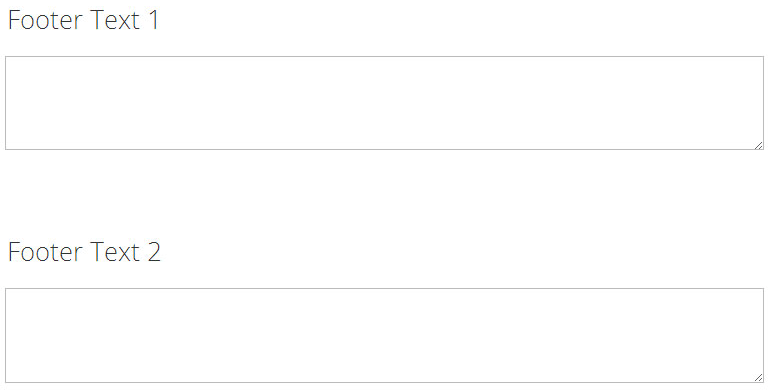Flatshop
Install WooCommerce Plugin
This theme requires WooCommerce plugin. Once you installed the WooCommerce plugin, you may customize the plugin settings as you like. If you want to follow our theme design, please set the product image sizes at WooCommerce > Settings > Catalog as follow:
- Catalog Images: 200 x 160px
- Single Product Image: 600 x 380px (used as product image in archive and single)
- Product Thumbnails: 58 x 58px (product gallery thumbnails)
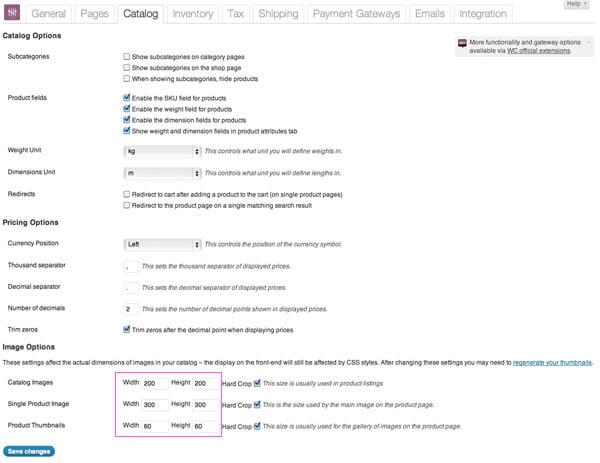
Note: for proper functioning of the dynamic add to cart feature, please go to WooCommerce > Settings, and in the Product tab, make sure the checkbox labeled "Redirect to the basket page after successful addition" is unchecked.
For more details on how to use WooCommerce, please refer to WooCommerce documentation.
Installing the Theme
To install themes with the WordPress theme uploader:
- Download the "theme.zip" file from the Member Area
- Note: some browsers (eg. Safari) auto extract zip files automatically. Right-click on the download link and select "Save Linked File As". This will allow you to download the theme as a zip file.
- Login to your site's WP Admin.
- Go to Appearance > Themes.
- Click on the "Add New" button, then click on the "Upload Theme" button
- Upload the theme.zip file (note: it is the theme.zip, not the theme-psd.zip that you just downloaded from the Member Area).
- Activate the theme
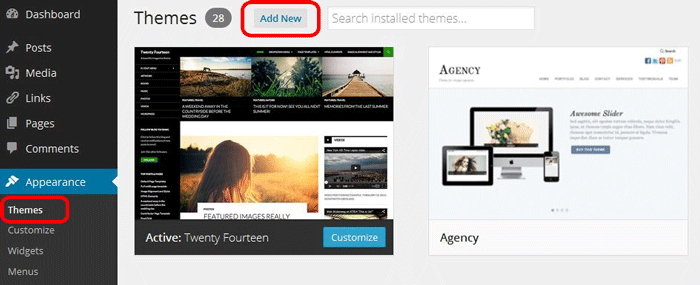
FYI: You can also install themes with FTP method. Read the Installing Themes tutorial for more info.
Demo Import
If you are starting a fresh site, importing the demo content will help you understand how the theme demo is built. The Demo Import feature will import the contents (posts, pages, comments, etc.), Themify panel settings, menus, and widgets setup from our demo to your site. You can erase the demo content afterward.
To import the demo setup:
- Go to WP Admin > Themify > Settings > Demo Import and click "Import Demo" button.
- Note that the featured images will be replaced with an image placeholder for copyright reasons.
To erase the demo setup:
- On the Demo Import tab, click on the "Erase Demo" button which will then remove the demo content.
FYI: If the Demo Import does not work on your site, you can use the WP Admin > Tools > Import tool to import the demo content manually.
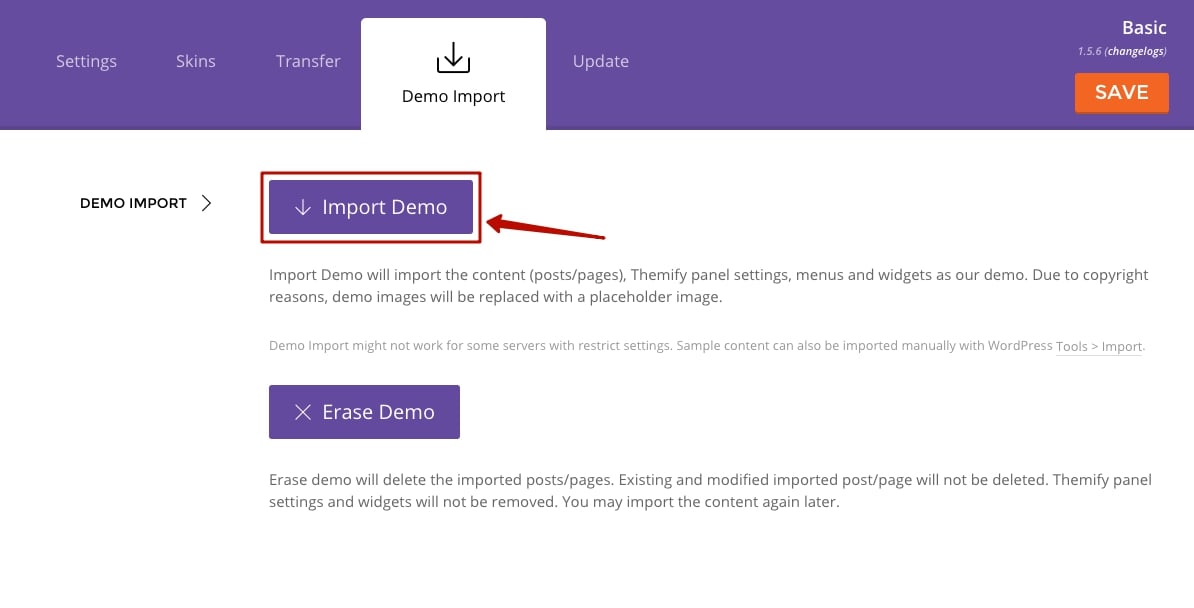
Site Logo & Tagline
To display a logo image instead of the site name text:
- Go to WP Admin > Appearance > Customize > Site Logo and Tagline.
- Under "Site Logo", select "Logo Image" radio button.
- Upload a logo image.
- Specify the logo image width and height.

You can also change website Tagline from here:
- Go to WP Admin > Appearance > Customize > Site Logo and Tagline.
- Scroll down and under "Site Tagline" select "Text" radio button.
- Enter your site Tagline.
- Click "Save & Publish".
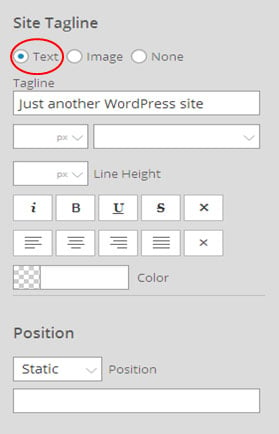
Main Navigation Menu
To create a custom navigation menu:
- Go to WP Admin > Appearance > Menus.
- Click on "create a new menu" to create a new menu (eg. Main Menu).
- Add the menu items from the left panels.
- To create a dropdown menu: drag the menu item towards the right (the item(s) will be indented).
- When you are done adding the menu items, click "Save Menu".
- To assign menu locations:
- Scroll down to the bottom where it says "Theme locations" and tick the menu location checkbox.
- Main Navigation = main menu on the header
- Footer Navigation = footer menu on the footer (Note: some themes might not have Footer Navigation).
TIPS: You can display menus on sidebar widgets, remove the main menu, create empty links, and lightbox links. Read Custom Menus for more detailed tutorial.
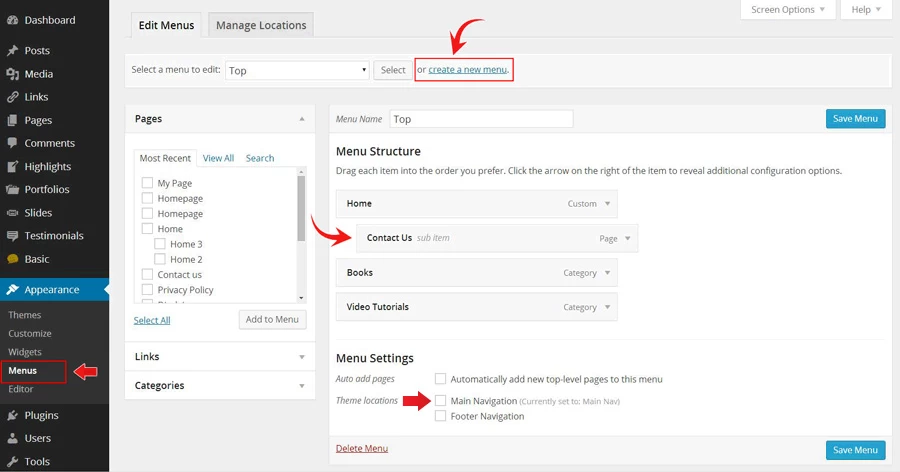
Setting Up the Social Links
Step 1) To set up the social media links:
- Go to WP Admin > Themify > Settings > Social Links tab.
- The theme comes with some pre-filled social links. Simply enter your social profile URL in the Link input field. For example, enter 'https://twitter.com/themify' for the Twitter link.
- You can choose to display either "Icon Font" or "Image".
- If "Icon Font" is selected, click on "Insert Icon" to select an icon (over 320+ icons available).
- If "Image" is selected, you can upload your own graphic icon by clicking on the Upload button.
- To add more links, click on the Add Link button at the bottom.
- To remove a link, click on the delete icon.
- To arrange the display order, drag and drop the link container.
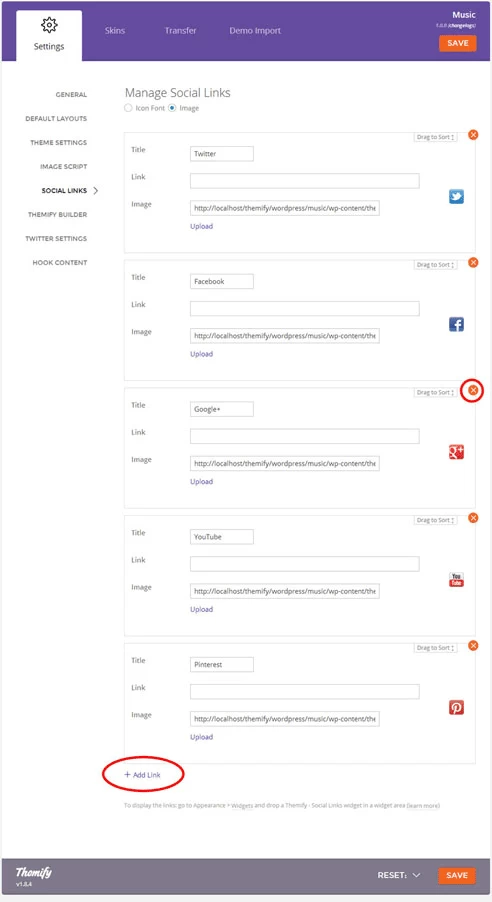
Step 2) Displaying the Social Links:
- Once you have the Social Links setup, go to WP Admin > Appearance > Widgets. Drag and drop the Themify - Social Links from the Available Widgets panel to the Social Widget panel.
- Optional: Customize Widget Title - such as "Follow Us". You can also "Show link name" and adjust icon size.
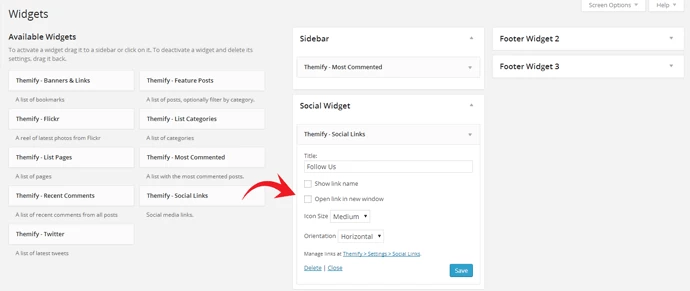
Hiding the RSS Icon
To hide the default RSS icon in the header:
- Go to WP Admin > Themify > Settings > Theme Settings.
- Under the "Exclude RSS Link", tick the checkbox that says "Check here to exclude RSS icon/button in the header".
Hiding the Search Form
To hide the default search form in the header:
- Go to WP Admin > Themify > Settings > Theme Settings.
- Under the "Exclude Search Form", tick the checkbox that says "Check here to exclude search form in the header".
Horizontal Menu
To add the Horizontal Menu:
- Go to WP > Appearance > Menus
- Create a new menu and assign it "Horizontal Menu" by checking the checkbox under "Theme locations" (refer to Custom Menus for more info on how to create menus)
WooCommerce Products
Flatshop includes a number of options specifically for customizing the look and feel of WooCommerce products.

These options can be found in the Themify Custom Panel when creating or editing a product.
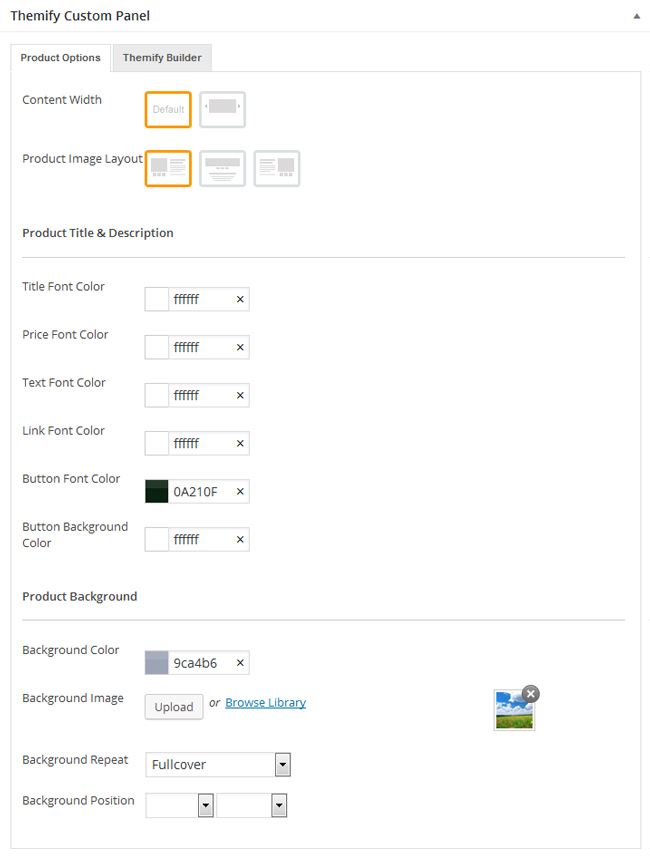
Options include:
- Product Image Layout - This option can be used to determine the layout of the product featured image, along with the product description and buttons on the product page.
- Title Font Color - Used to determine the color of the product title.
- Price Font Color - Sets the color used for the product price output.
- Text Font Color - Sets the color used for the main text of the product, such as short description, etc.
- Link Font Color - Sets the color for links in the main text of the product.
- Button Font Color - Used to determine the color of the text inside the buttons on a product page, such as add to cart button, etc.
- Button Background Color - Sets the background color of buttons.
- Background Color - Sets a background colour for the product listing.
- Background Image - Sets a background image to be used for the product listing.
- Background Repeat - Determines whether or not the background image will tile.
- Background Position - Used to set the positioning of the background iamge in the product listing.
Querying Products (Shop Pages)
In Flatshop you can now query products much like other post types using the Themify Custom Panel when adding or editing a page.
First create a page under WP > Pages > Add New and then check the "Query Products" tab of the Themify Custom Panel.
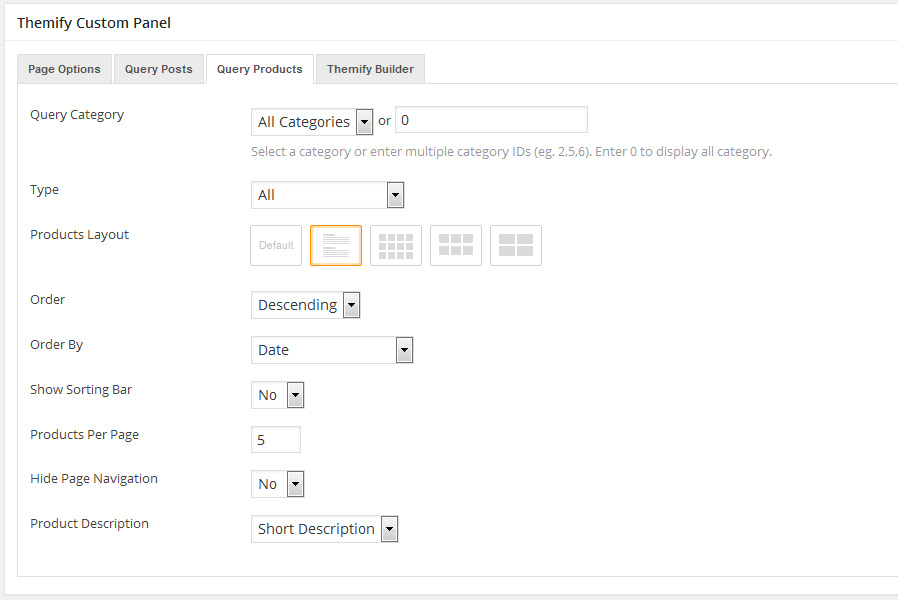
Options include:
- Query Category - Sets the category of products to display on the page.
- Products Layout - Determines how products will be displayed on the page, such as number of columns, etc.
- Order - Used to set whether to order products in ascending or descending order.
- Order By: - Determines what the products will be ordered by, such as publish date/time, title, etc.
- Products Per Page: - Sets the number of products displayed per page, i.e. the amount of products on the page before user has to use navigation links.
- Hide Page Navigation: - Used to hide the page navigation links for loading further products when the above limit is reached.
- Product Description: - Determines if a description will be shown for the products on the page, and if so which type of description to use.
Full-width Slider
Flatshop includes a full-width slider which can be included at the top of any page, including the home page, and will display custom slider post types based on the selected category.
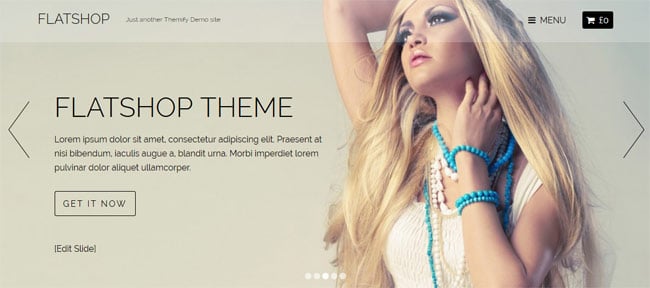
Adding Slider Posts
You can add new slider posts in the same way as any other post type in WordPress, by first navigating to the post type menu (in this case WP > Slider) and selecting "Add New"
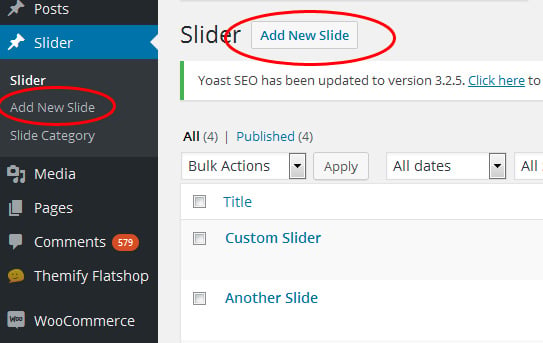
Once you have added a new slide, you will be presented with the WordPress post editor. Here you can enter a title for the slide, and use the WordPress WYSIWYG editor to set up any slide content, such as text or buttons, etc. You can also set a category for the slide which will then be used to group slides together when output on pages.
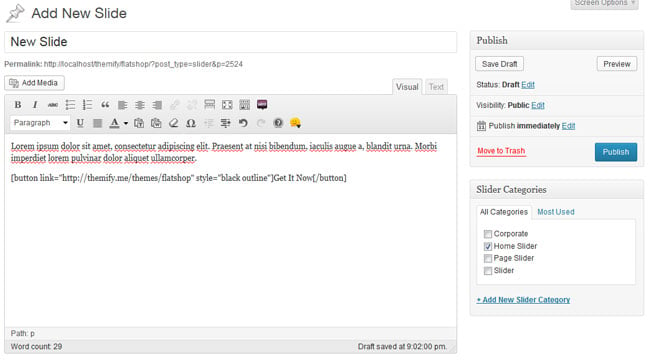
Button Shortcodes
You can use the [button] shortcode in the slider content to create action buttons. Below are some sample buttons (read the button documentation for more options):
[button link="https://themify.me/" style="red flat"]Themify[/button]
[button link="https://themify.me/themes/flatshop" style="black outline"]Get It Now[/button]
Slider Custom Panel
You will also see the Themify Custom Panel which has a number of options available for editing the look and content of slides.
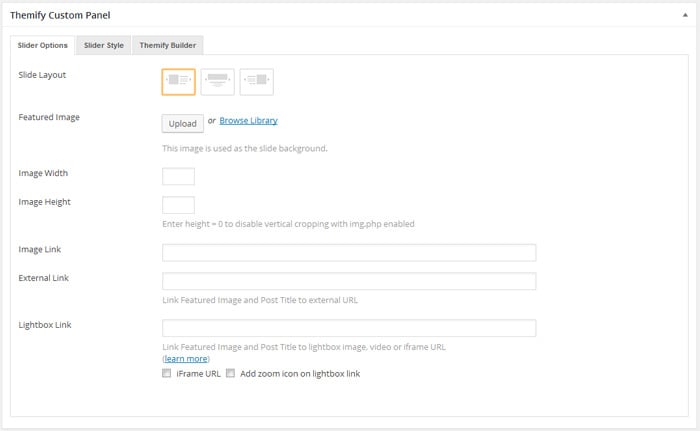
Options include:
- Slide Layout - This option determines the layout for the slide, such as placement of the slide content and featured image, etc.
- Featured Image - Use the options to set the image used for the slide.
- Image Width - Sets the width of the image used by the slide.
- Image Height - Sets the height of the image used by the slide.
- Image Link -
- External Link - Sets the link used by the slide title.
- Lightbox Link - Sets a link to be used by the slide which will be opened in a lightbox.
- iFrame URL - Sets the lightbox script to use an iFrame, for example if wanting to show another site or page in the lightbox.
- Add zoom icon - Adds a magnifying glass icon to the image.
Displaying the Slider on a Page
When creating or editing a page in WordPress you can use the Themify Custom Panel to set a slider category to be shown at the top of the page.
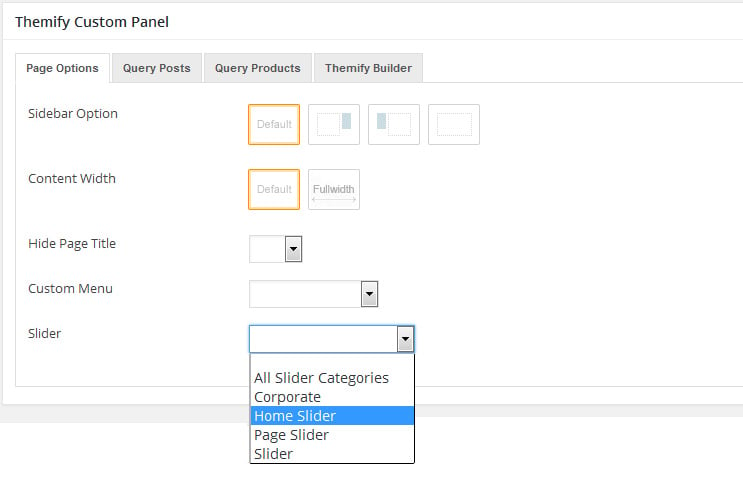
This option will allow you to select a category - or pull from all slider categories - and will then output that category's slides on the top of the page.
Slider Options
There are a number of options which can be set for all sliders under Themify > Settings > Theme Settings
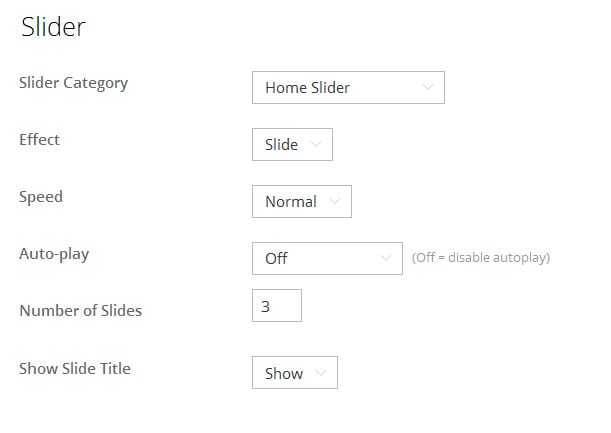
Options include:
- Slider Category - Sets the default category to be used for the slider, this will be used on the standard home page layout.
- Effect - Sets the transition effect used by the slider when switching slides.
- Speed - Sets the speed of transition when switching slides.
- Auto-play - Sets the time the slider will pause on each slide before switching slides automatically.
- Number of Slides - Sets the number of slides that will be shown.
Shop Settings
The shop settings option panel under Themify > Settings > Shop Settings is used to determine the standard layout of WooCommerce product archive pages and the single product pages.
Shop Page Settings
This section refers to the default product category/archive pages.
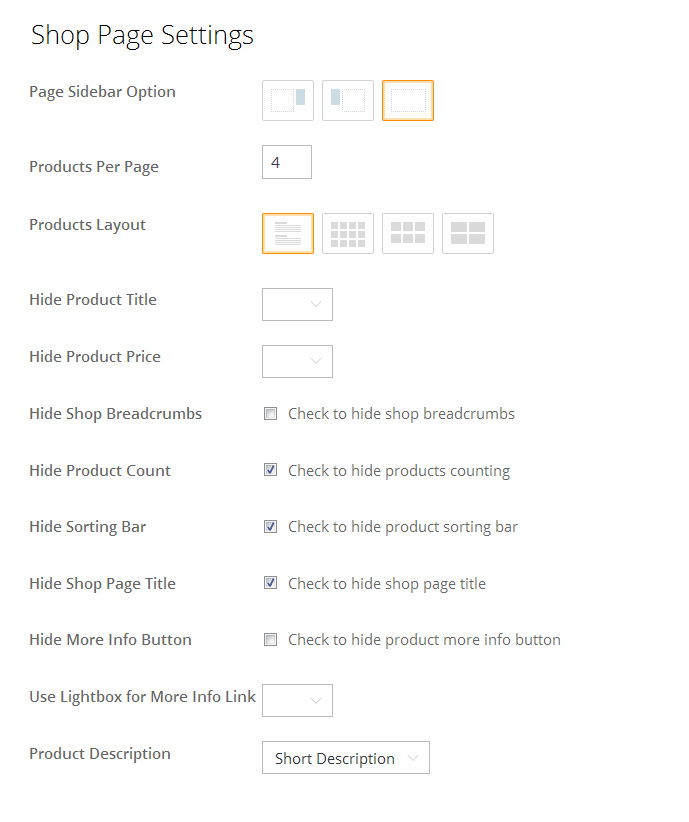
Options include:
- Page Sidebar Option - This will set whether the sidebar is displayed on the shop page and which side of the layout it will appear on.
- Products Per Page - Sets the number of products shown per page.
- Products Layout - Determines the way product listings will be shown on the page, such as number of columns, etc.
- Hide Product Title - Sets whether the product title should be shown or not.
- Hide Product Price - Sets whether the product price will be shown or not.
- Hide Shop Breadcrumbs - Determines whether the breadcrumbs will be shown, these show the user their current location within the store.
- Hide Product Count - Determines whether the product stock count will be shown.
- Hide Sorting Bar - Determines whether the list of sorting options is shown on the page.
- Hide Shop Page Title - Determines whether the shop page title will be shown on the page.
- Product Description - Sets whether a description will be shown, and which description to use, for the products.
Single Product Page
This section refers to the single product pages, which you will see when you select to view a single product from the listings.
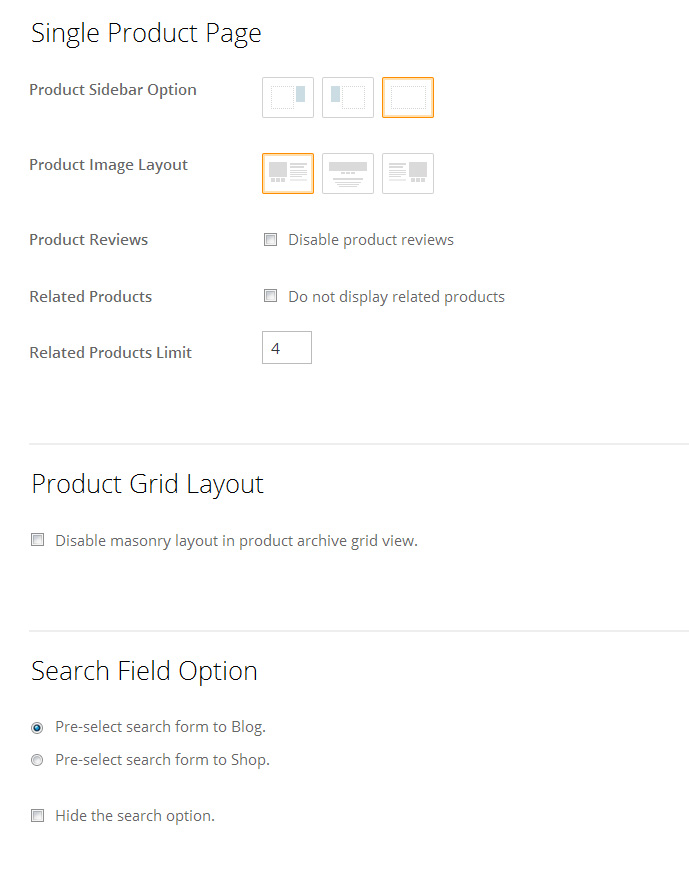
Options include:
- Product Sidebar Option - This will set whether the sidebar is displayed on the product page and which side of the layout it will appear on.
- Product Reviews - Sets whether the product reviews will be listed on the product page.
- Related Products - Sets whether the related products list will be shown on the product page.
- Related Products Limit - Sets how many related products will be shown at maximum.
Inserting Gallery to Posts or Pages
The gallery can be inserted in any post or page. To insert a gallery, click on "Add Media" button
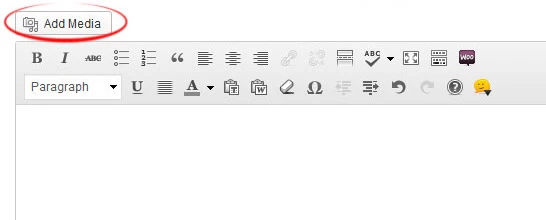
It will open a lightbox for you to create and insert gallery. Read this tutorial for more details on how to use WordPress Gallery.
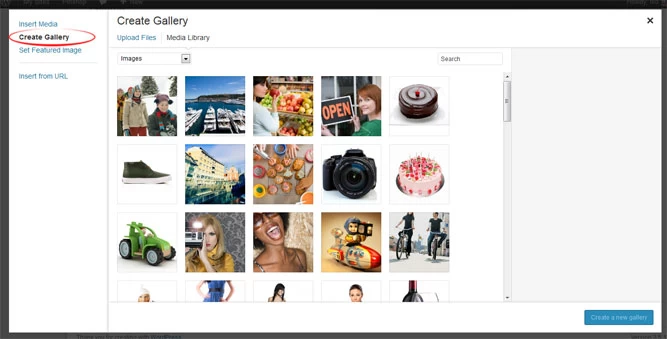
Footer Address & Map
To enter the footer address & map:
- Go to Themify > Settings > Theme Settings
- Enter the Address Info as you like (note that Address Info will display on the frontend, it is not a map)
- Enter the Phone Number (optional)
- Enter Opening Hours (optional)
- Enter Google Map Address (the address will be used as Google Map location)
- Select the Map Zoom level (optional)
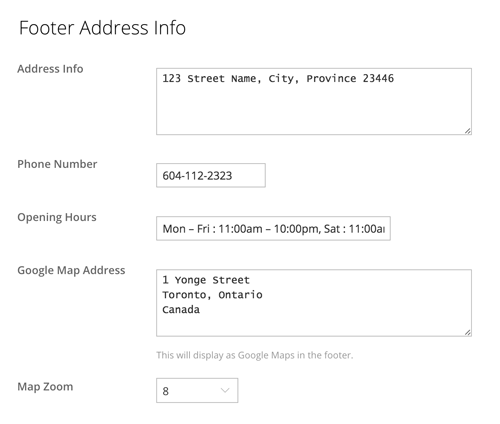
Setting Default Post and Page Layouts
Generally, the theme works out of the box. All the sidebar options and image dimensions are pre-defined in the theme. If you need to change the default sidebar options, featured image dimensions, content/except display, post meta, etc., it can be done in the WP Admin > Themify > Settings > Default Layouts.
There are three default layout options under Themify > Settings > Default Layouts:
- Archive Sidebar Option: refers to the default home page, category, search, archive, tag pages, etc.
- Default Post Layout: is the post page direct URL (also known as "Single Post").
- Note: Some themes may only have 4 layouts.
- Default Static Page Layout: is the static page.
FYI: Read Default Layouts documentation for more info.
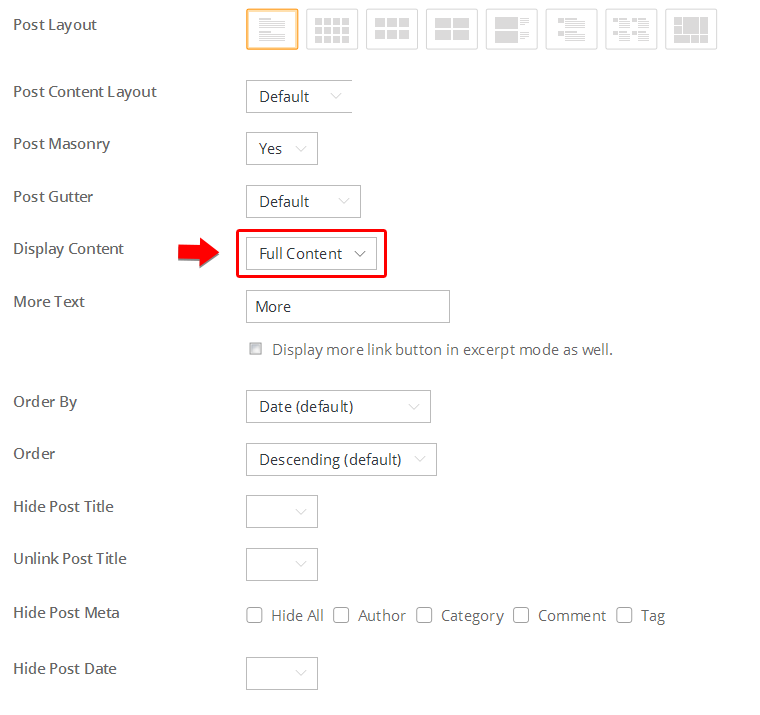
Creating a Blog Page (Query Posts)
To display/query posts on a page:
- First, create a new Page (in admin, select "Add New" under the "Pages" admin menu).
- In Themify Custom Panel, click "Query Posts" tab, select either "All Categories" or a Post category and select the other options as you like:
- Order = This option is used to set whether posts will be ordered in ascending or descending order.
- Order By = This option is used to set the attribute that the order of the post will be based on.
- Query Post Layout = This option is used to set the layout of posts such as grid columns, list posts, etc.
- Post Per Page = This option is used to set the number of posts shown per page.
- Display Content = This option is used to set what content is output for each post (None, Excerpt, or Full Content).
- Image Dimensions = This option is used to set the dimensions the posts images will be displayed at.
- Hide Post Title = This option is used to set whether the post title will be displayed.
- Unlink Post Title = This option is used to set whether the post title will operate as a link.
- Hide Post Date = This option is used to set whether the post date will be displayed.
- Hide Post Meta = This option is used to set whether the post meta will be displayed.
- Hide Featured Image = This option is used to set whether the featured image will be displayed.
- Unlink Featured Image = This option is used to set whether the featured image will operate as a link.
- Hide Page Navigation = This option is used to set whether the page navigation for posts will be displayed.

Setting a Custom Front Page
You can set any page as the front (home) page. This means you can use the Builder to design the page and assign it as the front page. To set the Front Page:
- Go to WP Admin > Settings > Reading.
- On the Front page displays, select the "A static page (select below)" option and then select a "Front page".
- Leave the "Posts page" default. If you want to create a custom Blog page, read this tutorial instead of setting the "Posts page".
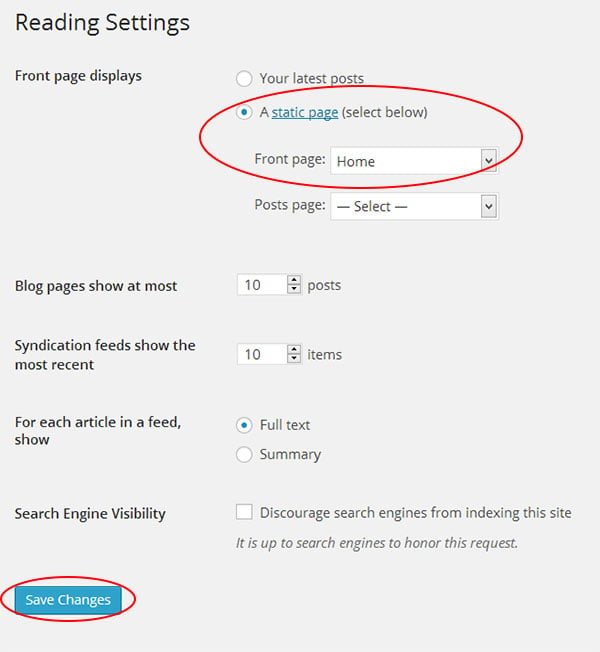
Adding Widgets
To add widgets to widgetized areas (eg. sidebar and footer widgets):
- Go to WP Admin > Appearance > Widgets.
- The big panel on the left side shows all available widgets. The small panels on the right are the widgetized areas.
- To add a widget: drag and drop the widget from the left panel to the right panel.
- To remove the widget: drag the widget back to the left panel (Available Widgets panel). If you want to keep the widget setting for future use, drag it to the Inactive Widgets instead of the Available Widgets panel. It will save your widget settings. To retrieve the widget, drag the widget from Inactive Widgets panel instead of the Available Widgets panel.
TIPS: You can also add widgets in Appearance > Customize panel.
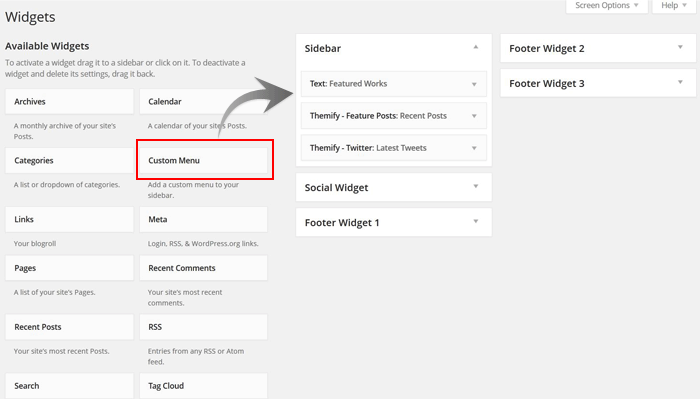
Theme Skins
To apply pre-designed color skins:
- Go to WP Admin > Themify > Skins, select a skin by clicking on the thumbnail and click Save.
Styling The Theme
To style the theme frontend appearance:
- Go to WP Admin > Appearance > Customize.
- It will take you to the Customize panel with live preview where you can style the appearance of the theme design (ie. color, background, font, spacing, border, etc.).
FYI: Refer to Customize documentation for more info.
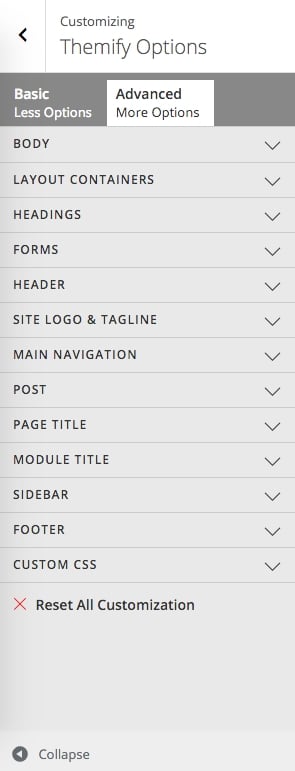
Footer Widgets
- To set the Footer Widget column layout, go to WP Admin > Themify > Settings > Theme Settings.

- To drop the widgets in the Footer Widgets, go to WP Admin > Appearance > Widgets.
Footer Text
To replace the footer credit links:
- Go to WP Admin > Themify > Settings > Theme Settings and enter the footer text.
- HTML tags are allowed in the Footer Text.
- To have empty footer text, tick the hide footer text checkbox.
